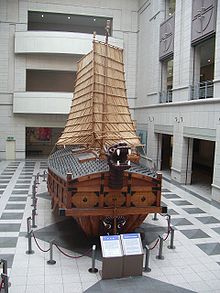Armored deck
Armored deck on warships denotes the horizontal termination, but subsequently also the intermediate floors and superstructures, which are reinforced by deck armor .
history
The first armored ships are already known in Korea in the 13th century for turtle ships . In the course of history, the armor was adapted to the development of weapons. The first German ships with armor were the cruiser corvettes SMS Princess Wilhelm and SMS Irene and the tank frigates SMS Kaiser and SMS Deutschland .
Armored decks and side armor
An armored deck is used to protect ships from the effects of such weapons that come from above or from the side. They developed in the 19th century as the threats from ship guns grew. Their grenades no longer hit the side of the ship's hull, but were fired in such a way that they described an arc and hit the deck . In terms of construction, a distinction was made between armoring the deck against attacks from hits from above on the deck and hits on the side surfaces. Armoring of the side surfaces was also known under the terms side armor and belt armor.
19th century
The first armored decks were installed on the French ship La Gloire from 1859. However, the Gloire was a wooden construction (and also planned as a wooden ship) with fittings made of iron plates. That is why the British HMS Warrior from 1860, which was planned and built as an armored ship from the start, is considered the first ironclad. The really first “operational and put into service” armored ship was the Warrior's sister ship , the HMS Black Prince , which was completed before the Warrior- class type ship .
The first battle between ships with armored decks was fought in the American Civil War on March 8 and 9, 1862 at Hampton Roads between the Monitor on the Union side and the Virginia of the Confederate States (formerly Merrimac ). Because the ships were similarly heavily armed and armored, it ended in a draw. They were both provided with armor plates about 10 cm thick.
20th century
At the beginning of the 20th century the cover plates got stronger and stronger. There was a race between the size of the caliber and the thickness of the cover plates. During the First World War , the armored ships reached their peak. The deck armor had grown to up to 63 mm for British and up to 70 mm for German battleships .
The Second World War heralded the end of armored ships. While the Japanese Yamato class received deck armor of up to 230 mm and belt armor up to 410 mm of steel, the designers had anticipated that the aircraft could play a decisive role in naval warfare even before the war . With increasingly heavier and partly guided aerial bombs it was possible to penetrate even the thickest armor. This made the heavy armored decks ineffective.
In the second half of the 20th century, ships with armored decks were no longer built.
Today, Kevlar mats are built in and on the side walls and magazines of ships in order to reinforce the relatively thin ship walls (which are often made of light metal in the area of the superstructures for weight reasons ) so that crew and ammunition cannot be hit by fragments flying around.
See also
literature
- Carl D. Park: Ironclad down. The USS Merrimack-CSS Virginia from construction to destruction. Naval Institute Press, Annapolis MD 2007, ISBN 978-1-59114-659-9 .
- William M. McBride: Technological change and the United States Navy, 1865-1945. Johns Hopkins University Press, Baltimore MD et al. 2000, ISBN 0-8018-6486-0 .
- David A. Mindell: War, technology, and experience aboard the USS Monitor. Johns Hopkins University Press, Baltimore MD et al. 2000, ISBN 0-8018-6250-7 .
- Siegfried Breyer: The armor of the German warships. (1920-1945) (= Marine-Arsenal. Special. 6). Podzun-Pallas, Wölfersheim-Berstadt 1997, ISBN 3-7909-0535-6 .
Individual evidence
- ↑ Turtle Ship - world.kbs.co.kr September 29, 2007 ( Memento of 29 September 2007 at the Internet Archive )



